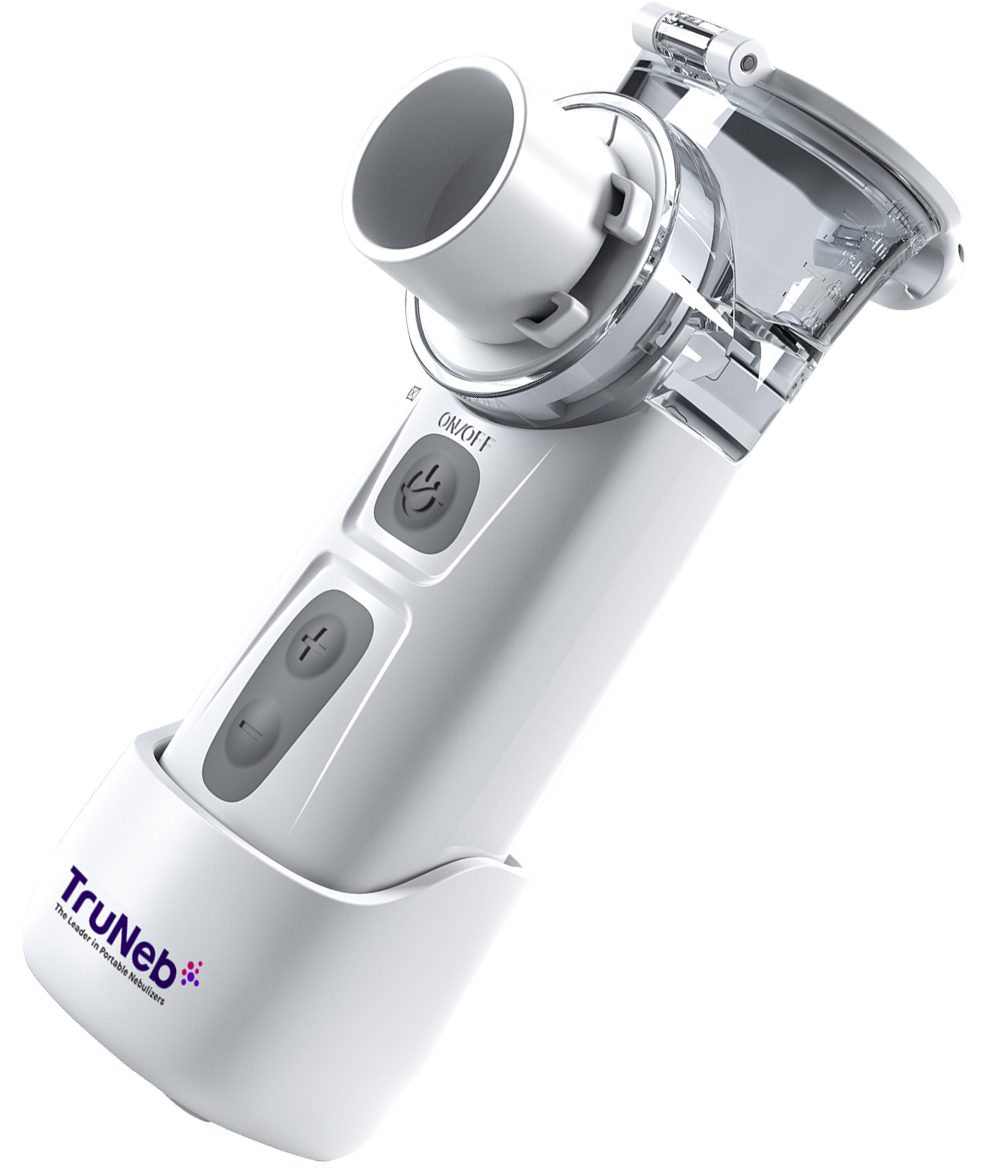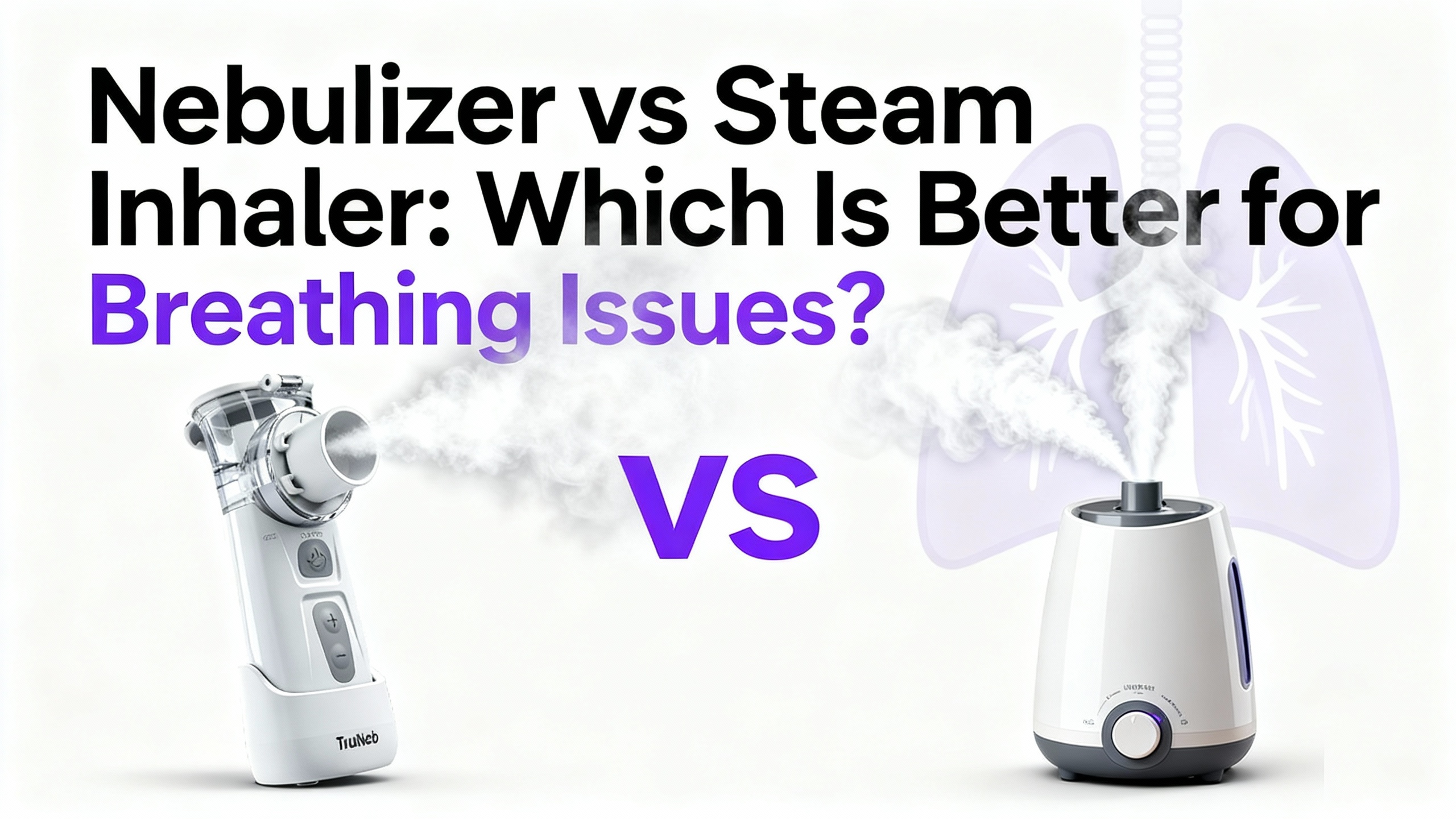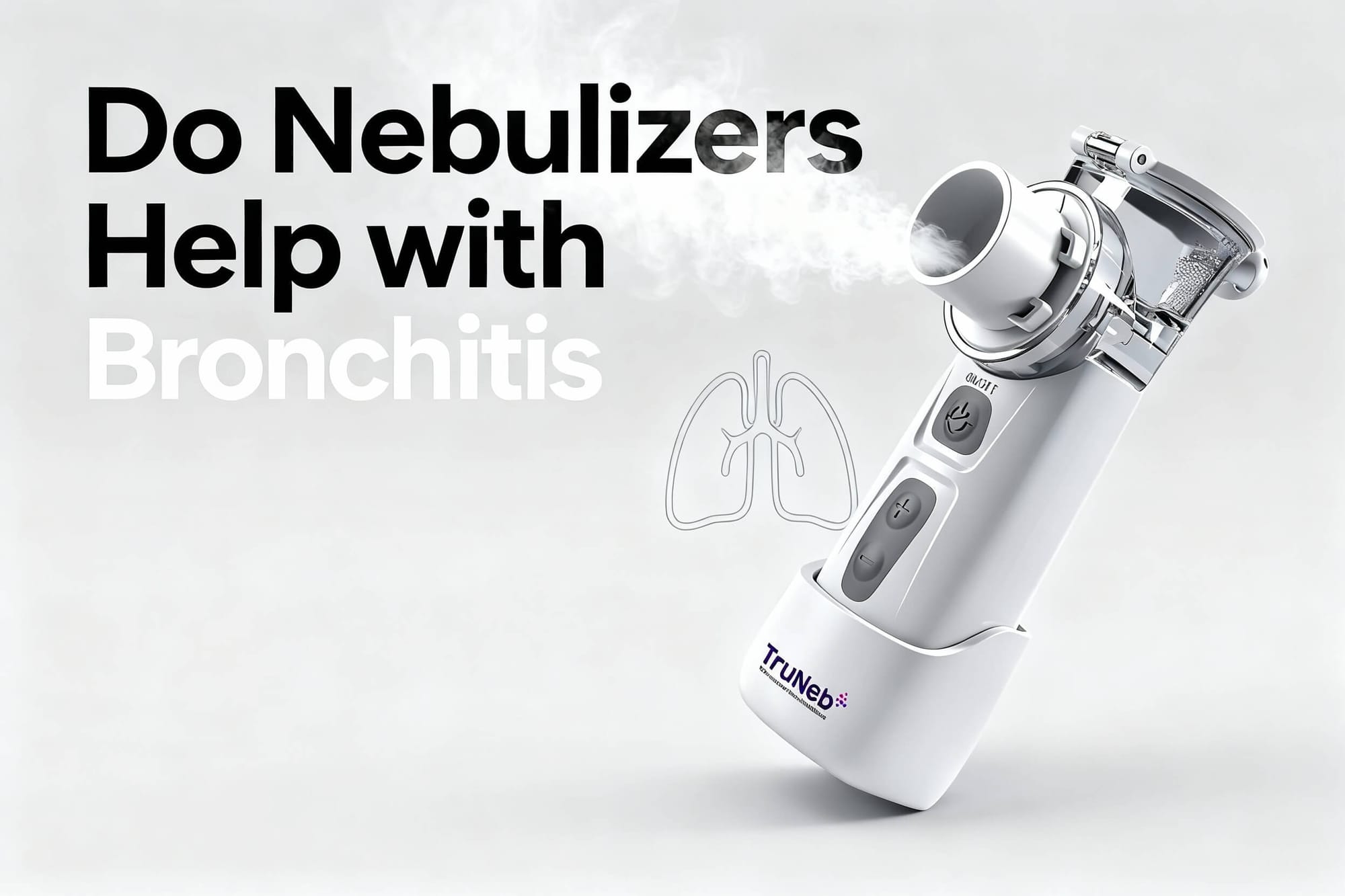On this page
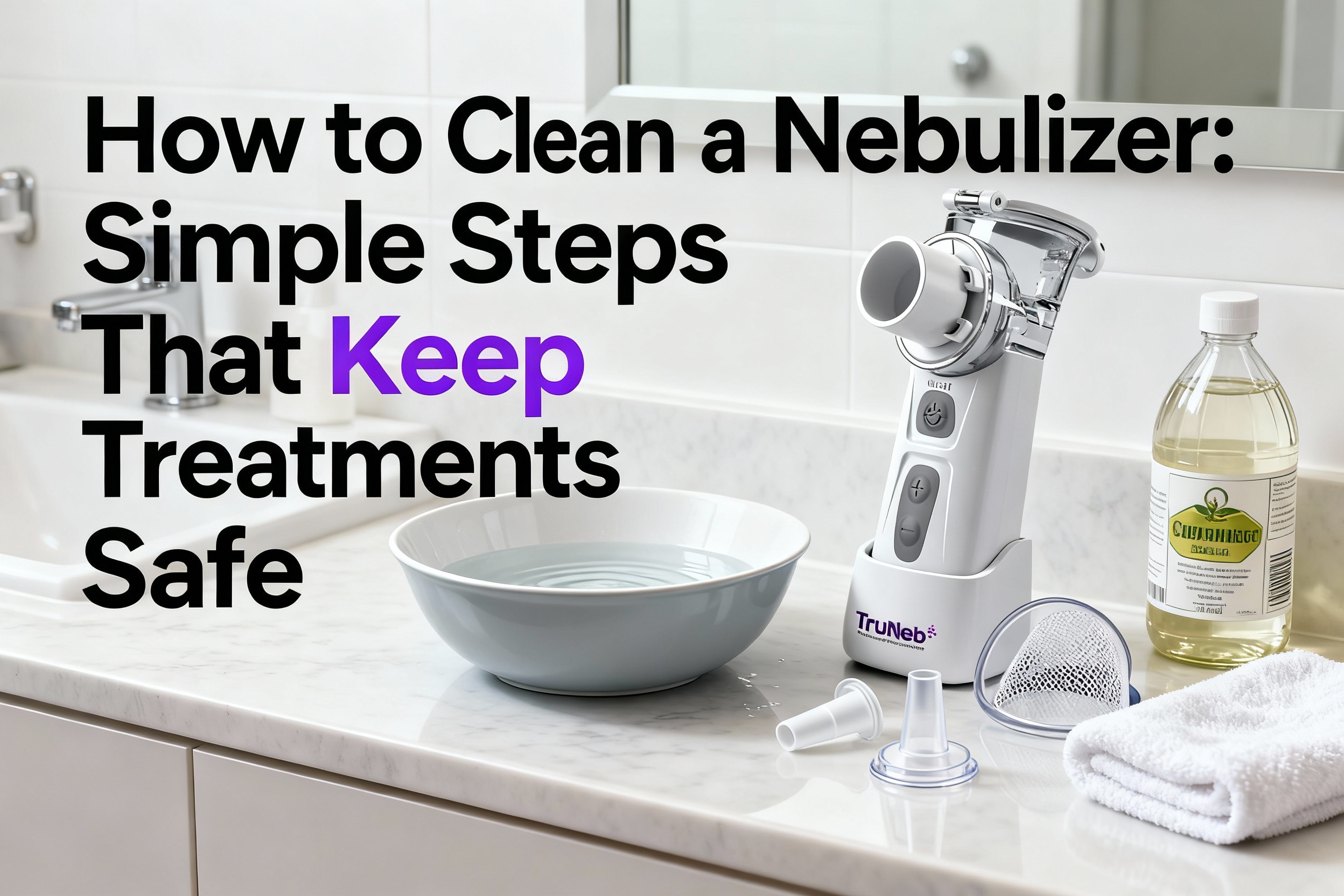
Why Cleaning Your Nebulizer Is Critical
A nebulizer turns liquid medicine into a fine mist so it reaches your lungs. If the parts aren’t cleaned, germs and leftover medicine can build up. That can lower how well treatments work and can raise your risk of lung infections.
Studies found up to 70% of home nebulizers showed bacterial contamination, which is linked to flare-ups in people with lung disease. Regular cleaning after each use and a weekly disinfect helps keep your breathing gear safe.
Rule of thumb: rinse after every use, disinfect weekly.
Dirty nebulizers can reduce treatment performance and increase the risk of infection, so clean after each use and disinfect weekly.
Nebulizer Parts and Prep
Before you start, unplug the nebulizer machine (compressor) and set up on a clean, dust-free surface.
Parts you’ll clean:
- Medicine cup (also called nebulizer cup)
- Top piece and small insert/baffle (if your cup has one)
- Mouthpiece or face mask
Parts you won’t wash:
- Tubing (keep it dry; don’t run water through it)
- Compressor (the motor unit)
Quick prep checklist:
- Wash your hands with soap and water.
- Gather mild dish soap, a clean bowl, white vinegar, and paper towels or a lint-free cloth.
- Lay a clean towel for drying.
There are jet, ultrasonic, and mesh nebulizers. Most cleaning steps are similar, but always check your manual for any special rules.
Clean the cup, top piece, and mask or mouthpiece, and never wash the tubing or compressor.
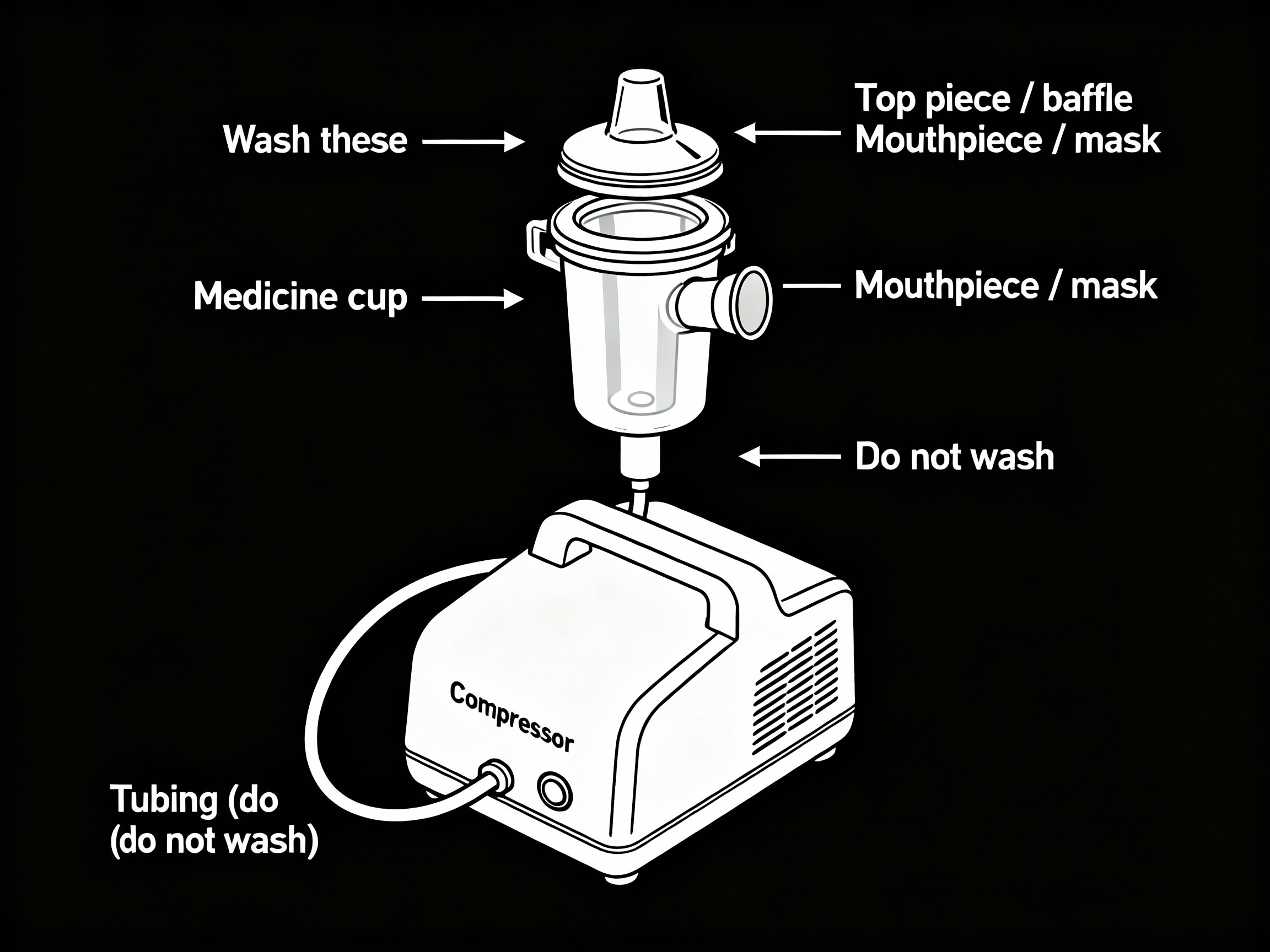
Step-by-Step: Clean After Each Use
- Turn off, unplug, and disassemble.
- Separate the mouthpiece or mask, top piece/baffle, and medicine cup. Set tubing and compressor aside (do not submerge these).
- Rinse parts under warm running water for about 30 seconds.
- Rinse the cup, top piece, and mouthpiece/mask to remove medicine residue. Do not run water through the tubing.
- If sticky, do a quick soap wash.
- Swish parts in warm water with a drop of mild, unscented dish soap, then rinse well so no soap remains.
- Shake off water and air-dry completely.
- Place parts on a clean paper towel or lint-free cloth. Let them dry fully before reassembly.
- Tip (optional): After parts are reassembled dry, you can run the compressor for a few seconds to ensure no moisture remains.
After each treatment, rinse the parts and let them air-dry completely so germs don’t linger.
Deep Clean: Disinfect Weekly
Disinfect the parts about once a week to kill germs that rinsing can miss. If you’re sick or at higher risk, your doctor might recommend disinfecting more frequently.
Method 1: Vinegar soak
- Mix 1 part white vinegar with 3 parts warm water in a clean bowl.
- Submerge the cleaned cup, top piece, and mouthpiece/mask for 20–30 minutes.
- Rinse well (sterile or boiled-and-cooled water is best), then air-dry.
Method 2: Other cold disinfectants
- 70% isopropyl alcohol: soak 5 minutes, then rinse and air-dry.
- 3% hydrogen peroxide: soak 30 minutes, then rinse and air-dry.
- Some manufacturers offer commercial disinfectant solutions — follow the product instructions and your device manual.
- Do not use bleach on nebulizer parts.
Method 3: Heat (only if your manual says it’s allowed)
- Boil parts in water for about 5 minutes, or use a baby bottle steam sterilizer or microwave steam bag as directed.
- Let parts cool, then air-dry.
Discard any used solution after each disinfect. Don’t reuse it.
Once a week, disinfect the washed parts with vinegar, alcohol, peroxide, or approved heat if your manual allows it.
| Task | What to do | When |
|---|---|---|
| Quick clean | Rinse cup, top/baffle, and mouthpiece or mask; air-dry completely | After every use |
| Soap wash | Wash with mild dish soap; rinse well so no residue remains | End of day or if sticky |
| Disinfect | Vinegar 1:3 for 20–30 min (or 70% alcohol 5 min, 3% peroxide 30 min); rinse and air-dry | Weekly (or more often if advised) |
| Tubing | Keep dry; do not wash inside; replace if moisture or mold appears | Replace every 1–2 months or sooner if wet/moldy |
| Filters | Check and replace per the device manual | Typically every 1–6 months |
| Mask/cup | Replace if cracked, discolored, or mist output drops | About every 6 months (reusable kits) |
Note: Always follow your device manual for any heat or dishwasher use; replacement intervals vary by model and usage.
Tubing and Compressor Care
- Do not rinse or soak the tubing. Moisture trapped inside can grow mold. If condensation appears, connect the tubing to the compressor (no cup attached) and run air a few minutes to dry it. If it won’t dry, replace it.
- Never submerge the nebulizer machine (compressor). Wipe the outside with a damp cloth or disinfectant wipe while unplugged.
- Check the air filter. Replace it as the manual directs (typically when discolored or every few months). Do not run the machine without a proper filter.
Keep tubing dry and replace it regularly; wipe the compressor and change filters on schedule.
Extra Tips for Safe, Easy Cleaning
- Use mild, unscented dish soap. Strong cleaners can leave residue you may inhale.
- Skip bleach and harsh chemicals.
- Dishwasher? Only if your manual says parts are top-rack safe. Masks often warp in dishwashers, so hand wash is best.
- Dry parts in a clean, low-dust area. Try cleaning after vacuuming so dust has settled.
- Store fully dry parts in a clean container or sealed bag.
- Portable mesh nebulizers (like the TruNeb™ Portable Mesh Nebulizer) can have delicate mesh heads. Avoid heat unless the manual allows it and follow the device’s care steps.
- You might see products labeled 'steam inhaler' — these are NOT nebulizers and aren’t for breathing medicines or cleaning steps.
- When in doubt, follow your manufacturer’s instructions.
Use mild soap, avoid bleach, check your manual, and store parts totally dry in a dust-free place.
Safety & Medical Disclaimer
- This guide is educational. Talk to your doctor before changing your cleaning routine, disinfectant method, or any medication.
- ⚠️ If you notice mold in parts, if your breathing suddenly worsens, or you have signs of infection (fever, chest pain, blood in mucus), seek medical care right away.
When to Replace Nebulizer Parts (Maintenance 101)
Cleaning helps parts last, but they still wear out.
- Reusable nebulizer kits (cup + mouthpiece/mask) usually last about 6 months.
- Disposable kits are typically for about 10–14 uses.
- Tubing is not cleanable; replace every 1–2 months or sooner if wet or dirty.
- Filters vary by model; replace on schedule or when discolored.
- Replace any part that’s cracked, discolored, or if mist output drops even after cleaning.
Replace tubing every 1–2 months and masks/cups about every 6 months, or sooner if damaged.
Frequently Asked Questions
Tap or click a question below to see the answer:
Clean (rinse or a quick soap wash) after every use. Disinfect about once a week. Your clinician may recommend disinfecting more often if you’re sick or at higher risk.
Use 70% isopropyl alcohol (soak 5 minutes) or 3% hydrogen peroxide (soak 30 minutes). Rinse with sterile or clean water and air-dry. If your manual allows heat, boiling or steam may be used for compatible parts.
Do not wash the inside of the tubing. Keep it dry. If moisture gets trapped or the tubing looks dirty, replace it. You can run compressor air through it briefly to dry; replace if it won’t fully dry.
Only if your manual says they’re top-rack safe. Masks often warp. Never place the compressor or tubing in the dishwasher.
Boiling can work for many reusable parts for about 5 minutes, but only if your manual allows it. Never boil tubing. If unsure, use a cold disinfect method.
Key Takeaways
Clean your nebulizer after each use and disinfect weekly. Keep tubing dry, replace worn parts on schedule, and follow your manual for anything device-specific. A few extra minutes of care can help your treatments work better and keep your lungs safer.

